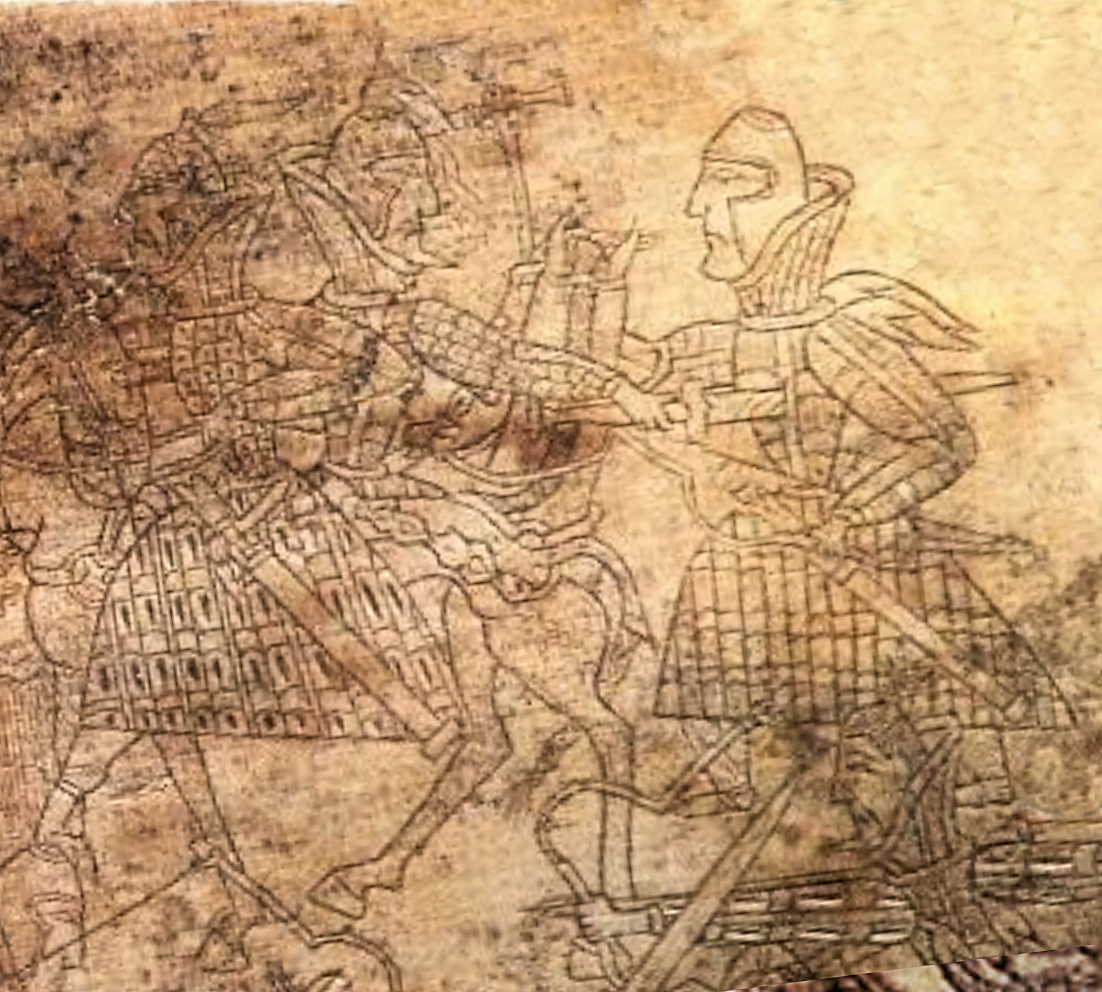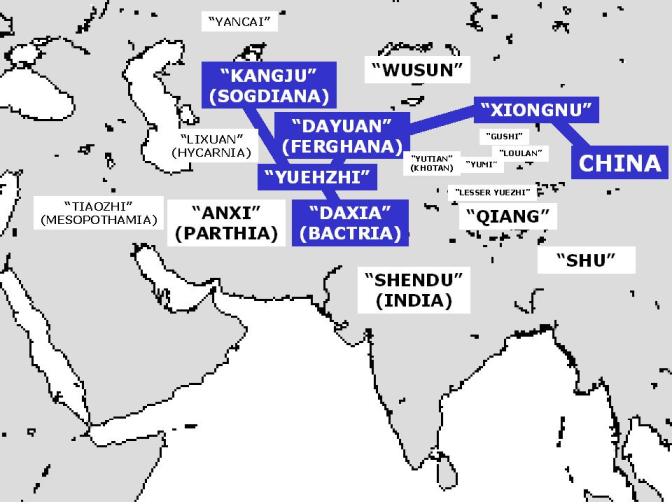|
Orlat Plaques
The Orlat plaques are a series of bone plaques that were discovered in the mid-1980s in Uzbekistan. They were found during excavations led by Galina Pugachenkova at the cemetery of Orlat, by the bank of the Saganak River (a tributary of the Zeravshan), immediately north of Samarkand. Pugachenkova published her finds in 1989. The left half is decorated with an elaborated battle scene, while on the other side is depicted a hunting scene. The plaques The plaques are thought to have been decorative belt buckles. They are decorated with battle scenes between soldiers armed as cataphracts, and one hunting scene. There are three other plaques, smaller in size, on which are depicted a vulture, fighting Bactrian camels, and warriors. The date and attribution of the plaques are disputed, although the consensus tends to suggest a 1st-century CE date. The plaque with the battle scene depicts a clash with armored warriors. There are soldiers battling on foot, and before them there is a hor ... [...More Info...] [...Related Items...] OR: [Wikipedia] [Google] [Baidu] |
Saka
The Saka ( Old Persian: ; Kharoṣṭhī: ; Ancient Egyptian: , ; , old , mod. , ), Shaka (Sanskrit ( Brāhmī): , , ; Sanskrit (Devanāgarī): , ), or Sacae (Ancient Greek: ; Latin: ) were a group of nomadic Iranian peoples who historically inhabited the northern and eastern Eurasian Steppe and the Tarim Basin. "Modern scholars have mostly used the name Saka to refer specifically to Iranians of the Eastern Steppe and Tarim Basin" "In modern scholarship the name 'Sakas' is reserved for the ancient tribes of northern and eastern Central Asia and Eastern Turkestan to distinguish them from the related Massagetae of the Aral region and the Scythians of the Pontic steppes. These tribes spoke Iranian languages, and their chief occupation was nomadic pastoralism." The Sakas were closely related to the European Scythians, and both groups formed part of the wider Scythian cultures and ultimately derived from the earlier Andronovo culture, and the Saka language formed part of ... [...More Info...] [...Related Items...] OR: [Wikipedia] [Google] [Baidu] |
Mongolia
Mongolia; Mongolian script: , , ; lit. "Mongol Nation" or "State of Mongolia" () is a landlocked country in East Asia, bordered by Russia to the north and China to the south. It covers an area of , with a population of just 3.3 million, making it the world's most sparsely populated sovereign nation. Mongolia is the world's largest landlocked country that does not border a closed sea, and much of its area is covered by grassy steppe, with mountains to the north and west and the Gobi Desert to the south. Ulaanbaatar, the capital and largest city, is home to roughly half of the country's population. The territory of modern-day Mongolia has been ruled by various nomadic empires, including the Xiongnu, the Xianbei, the Rouran, the First Turkic Khaganate, and others. In 1206, Genghis Khan founded the Mongol Empire, which became the largest contiguous land empire in history. His grandson Kublai Khan conquered China proper and established the Yuan dynasty. After the co ... [...More Info...] [...Related Items...] OR: [Wikipedia] [Google] [Baidu] |
Indo-Scythian
Indo-Scythians (also called Indo-Sakas) were a group of nomadic Iranian peoples of Scythian origin who migrated from Central Asia southward into modern day Pakistan and Northwestern India from the middle of the 2nd century BCE to the 4th century CE. The first Saka king of India was Maues/Moga (1st century BCE) who established Saka power in Gandhara, Pakistan and the Indus Valley. The Indo-Scythians extended their supremacy over north-western India, conquering the Indo-Greeks and other local kingdoms. The Indo-Scythians were apparently subjugated by the Kushan Empire, by either Kujula Kadphises or Kanishka. Yet the Saka continued to govern as satrapies, forming the Northern Satraps and Western Satraps. The power of the Saka rulers started to decline in the 2nd century CE after the Indo-Scythians were defeated by the Satavahana emperor Gautamiputra Satakarni. Indo-Scythian rule in the northwestern Indian subcontinent ceased when the last Western Satrap Rudrasimha III was defeated ... [...More Info...] [...Related Items...] OR: [Wikipedia] [Google] [Baidu] |
Indo-Scythians
Indo-Scythians (also called Indo-Sakas) were a group of nomadic Iranian peoples of Scythian origin who migrated from Central Asia southward into modern day Pakistan and Northwestern India from the middle of the 2nd century BCE to the 4th century CE. The first Saka king of India was Maues/Moga (1st century BCE) who established Saka power in Gandhara, Pakistan and the Indus Valley. The Indo-Scythians extended their supremacy over north-western India, conquering the Indo-Greeks and other local kingdoms. The Indo-Scythians were apparently subjugated by the Kushan Empire, by either Kujula Kadphises or Kanishka. Yet the Saka continued to govern as satrapies, forming the Northern Satraps and Western Satraps. The power of the Saka rulers started to decline in the 2nd century CE after the Indo-Scythians were defeated by the Satavahana emperor Gautamiputra Satakarni. Indo-Scythian rule in the northwestern Indian subcontinent ceased when the last Western Satrap Rudrasimha III was defea ... [...More Info...] [...Related Items...] OR: [Wikipedia] [Google] [Baidu] |
Parthian Empire
The Parthian Empire (), also known as the Arsacid Empire (), was a major Iranian political and cultural power in ancient Iran from 247 BC to 224 AD. Its latter name comes from its founder, Arsaces I, who led the Parni tribe in conquering the region of Parthia in Iran's northeast, then a satrapy (province) under Andragoras, who was rebelling against the Seleucid Empire. Mithridates I (r. c. 171–132 BC) greatly expanded the empire by seizing Media and Mesopotamia from the Seleucids. At its height, the Parthian Empire stretched from the northern reaches of the Euphrates, in what is now central-eastern Turkey, to present-day Afghanistan and western Pakistan. The empire, located on the Silk Road trade route between the Roman Empire in the Mediterranean Basin and the Han dynasty of China, became a center of trade and commerce. The Parthians largely adopted the art, architecture, religious beliefs, and royal insignia of their culturally heterogene ... [...More Info...] [...Related Items...] OR: [Wikipedia] [Google] [Baidu] |
Yuezhi
The Yuezhi (;) were an ancient people first described in Chinese histories as nomadic pastoralists living in an arid grassland area in the western part of the modern Chinese province of Gansu, during the 1st millennium BC. After a major defeat at the hands of the Xiongnu in 176 BC, the Yuezhi split into two groups migrating in different directions: the Greater Yuezhi (''Dà Yuèzhī'' 大月氏) and Lesser Yuezhi (''Xiǎo Yuèzhī'' 小月氏). This started a complex domino effect that radiated in all directions and, in the process, set the course of history for much of Asia for centuries to come. The Greater Yuezhi initially migrated northwest into the Ili River, Ili Valley (on the modern borders of China and Kazakhstan), where they reportedly displaced elements of the Sakas. They were driven from the Ili Valley by the Wusun and migrated southward to Sogdia and later settled in Bactria. The Greater Yuezhi have consequently often been identified with peoples mentioned in classica ... [...More Info...] [...Related Items...] OR: [Wikipedia] [Google] [Baidu] |
Sakas
The Saka (Old Persian: ; Kharosthi, Kharoṣṭhī: ; Egyptian language, Ancient Egyptian: , ; , Old Chinese, old , Pinyin, mod. , ), Shaka (Sanskrit (Brahmi script, Brāhmī): , , ; Sanskrit (Devanagari, Devanāgarī): , ), or Sacae (Ancient Greek: ; Latin: ) were a group of nomadic Iranian peoples who historically inhabited the northern and eastern Eurasian Steppe and the Tarim Basin. "Modern scholars have mostly used the name Saka to refer specifically to Iranians of the Eastern Steppe and Tarim Basin" "In modern scholarship the name 'Sakas' is reserved for the ancient tribes of northern and eastern Central Asia and Eastern Turkestan to distinguish them from the related Massagetae of the Aral region and the Scythians of the Pontic steppes. These tribes spoke Iranian languages, and their chief occupation was nomadic pastoralism." The Sakas were closely related to the European Scythians, and both groups formed part of the wider Scythian cultures and ultimately derived f ... [...More Info...] [...Related Items...] OR: [Wikipedia] [Google] [Baidu] |
Sogdians ...
:''This category lists articles related to historical Iranian peoples'' Historical Peoples Iranian Iranian Iranian Iranian may refer to: * Iran, a sovereign state * Iranian peoples, the speakers of the Iranian languages. The term Iranic peoples is also used for this term to distinguish the pan ethnic term from Iranian, used for the people of Iran * Iranian lan ... [...More Info...] [...Related Items...] OR: [Wikipedia] [Google] [Baidu] |
Khalchayan
Khalchayan (also ''Khaltchaïan'') is an archaeological site, thought to be a small palace or a reception hall, located near the modern town of Denov in Surxondaryo Region of southern Uzbekistan. It is located in the valley of the Surkhan Darya, a northern tributary of the Oxus (modern Amu Darya). Terracotta statues The site is usually attributed to the early Kushans, or their ancestors the Yuezhi/Tocharians. It was excavated by Galina Pugachenkova between 1959 and 1963. The interior walls are decorated with clay sculptures and paintings dated to the mid-1st century BCE, but they are thought to represent events as early as the 2nd century BCE. Various panels depict scenes of Kushan life: battles, feasts, portraits of rulers. Some of the Khalchayan sculptural scenes are thought to depict the Kushans fighting against a Saka tribe. The Yuezhis are shown with a majestic demeanour, whereas the Sakas are typically represented with side-wiskers in more or less grotesque attitudes."The k ... [...More Info...] [...Related Items...] OR: [Wikipedia] [Google] [Baidu] |
Tocharians
The Tocharians, or Tokharians ( US: or ; UK: ), were speakers of Tocharian languages, Indo-European languages known from around 7600 documents from around 400 to 1200 AD, found on the northern edge of the Tarim Basin (modern Xinjiang, China).. "Our knowledge of the Tocharian languages derives essentially from c. 7600 documents found across about thirty sites in the eastern half of the greater Tarim Basin (Fig. 1). The documents date from c. 400 to 1200 CE" The name "Tocharian" was given to these languages in the early 20th century by scholars who identified their speakers with a people known in ancient Greek sources as the ''Tókharoi'' (Latin ''Tochari''), who inhabited Bactria from the 2nd century BC. This identification is generally considered erroneous, but the name "Tocharian" remains the most common term for the languages and their speakers. Their actual ethnic name is unknown, although they may have referred to themselves as ''Agni'', '' Kuči'' and ''Krorän'', or ''Ag ... [...More Info...] [...Related Items...] OR: [Wikipedia] [Google] [Baidu] |
Kushans
The Kushan Empire ( grc, Βασιλεία Κοσσανῶν; xbc, Κυϸανο, ; sa, कुषाण वंश; Brahmi: , '; Buddhist Hybrid Sanskrit, BHS: ; xpr, 𐭊𐭅𐭔𐭍 𐭇𐭔𐭕𐭓, ; zh, wikt:貴霜, 貴霜 ) was a Syncretism, syncretic empire, formed by the Yuezhi, in the Bactrian territories in the early 1st century. It spread to encompass much of modern-day territory of, Afghanistan, Pakistan, Uzbekistan, and northern India, at least as far as Saketa and Sarnath near Varanasi (Benares), where inscriptions have been found dating to the era of the Kushan Emperor Kanishka the Great. The Kushans were most probably one of five branches of the Yuezhi confederation, an Indo-European peoples, Indo-European nomadic people of possible Tocharians, Tocharian origin, who migrated from northwestern China (Xinjiang and Gansu) and settled in ancient Bactria. The founder of the dynasty, Kujula Kadphises, followed Greek religious ideas and iconography after the Greco-B ... [...More Info...] [...Related Items...] OR: [Wikipedia] [Google] [Baidu] |
Kangju
Kangju (; Eastern Han Chinese: ''kʰɑŋ-kɨɑ'' < *''khâŋ-ka'' (c. 140 BCE)) was the Chinese name of a kingdom in during the first half of the CE. The name ''Kangju'' is now generally regarded as a variant or mutated form of the name . According to contemporaneous Chinese sources, Kangju was the second most powerful state in , after the . [...More Info...] [...Related Items...] OR: [Wikipedia] [Google] [Baidu] |


%2C_Nisa_mint.jpg)


.jpg)

